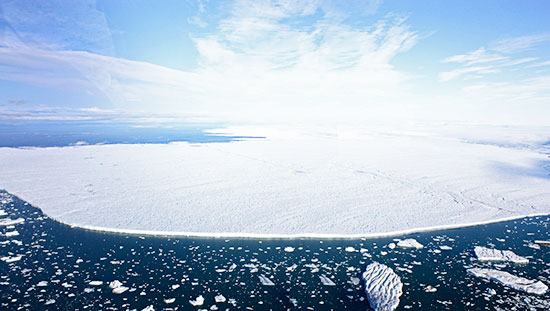


All of us—consider the infrastructure needs and costs as homes, businesses, highways, bridges and dams risk being submerged, and people are displaced; the potential impacts on the cities and historic communities that give Delaware its character; the loss of wildlife and more.
By tracey bryant
Office of Communications
& Marketing

The extent of sea ice in the Arctic reached a record low in 2012, according to the U.S. National Snow and Ice Data Center (NSIDC).
Andreas Muenchow, a University of Delaware marine scientist, confirmed some of that ice loss firsthand while doing research off Greenland from aboard the Canadian icebreaker Henry Larsen this past August. He produced a short video that shows the ice-free sea off Petermann Fjord in which the ship was sailing — an area that previously, for ages, had been covered by floating ice shelves.
“But it is no more,” notes Muenchow in the video. He and his research team from UD’s College of Earth, Ocean, and Environment (CEOE) were working in Nares Strait, between Greenland and Canada, to recover an ocean and sea ice observing array they had moored there in 2009 as part of his National Science Foundation research project.
“What we see in Nares Strait is some of the hardest and thickest ice leaving the Arctic with some of it being replaced by much thinner ice that has not been hardened by many sequential freeze/melt cycles,” said Muenchow, an associate professor in CEOE’s School of Marine Science and Policy.
“The harder thicker ice is called ‘multi-year’ ice, distinct from first-year ice. The slow disappearance of this multi-year ice from northern Canada and Greenland is one major factor causing the ice extent to become steadily smaller over the last 40 years or so. Most climate models predicted this scenario, but we are 30 to 40 years ahead of the predicted schedule with regard to the ice cover in the Arctic,” Muenchow says.
According to NSIDC, the extent of Arctic sea ice on Aug. 13 was 1.97 million square miles. That figure was 1.04 million square miles below the 1979 to 2000 average extent for the date, and 186,000 square miles below the previous record low for the date, which occurred in 2007.
On his expedition, Muenchow observed Petermann Glacier and the island of ice, twice the size of Manhattan, that broke off from it on July 16, which weeks eariler he had confirmed from his UD office using satellite data and had reported in his “Icy Seas” blog.
On Aug. 24, while still in the Arctic, Muenchow blogged that another ice island—about three times the size of New York’s Central Park—had broken off from nearby Steensby Gletscher.
The instruments Muenchow recovered are now yielding data on currents, temperature, salinity and ice thickness recorded at better than hourly intervals since 2009, including passage of the “superchunk” four times the size of Manhattan that broke off Petermann Glacier in 2010.